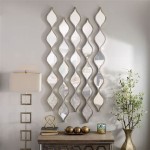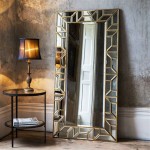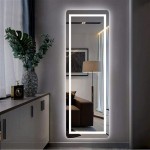TV with Mirror: A Fusion of Functionality and Style
The concept of integrating a TV with a mirror isn't entirely new. For years, manufacturers have explored ways to blend technology with everyday objects, seeking to enhance functionality and aesthetics. However, the recent surge in popularity of TVs with integrated mirrors signifies a significant shift in how we perceive and interact with our home entertainment systems. This innovation offers a unique blend of functionality and style, catering to both practical and aesthetic needs within modern living spaces.
Blending Form and Function
The allure of a TV with a mirror stems from its ability to seamlessly transition between two distinct roles: a captivating entertainment hub and a stylish reflective surface. When the TV is off, it acts as a conventional mirror, reflecting the room and enhancing its aesthetic appeal. This versatility allows for space optimization, eliminating the need for separate mirrors while simultaneously offering a convenient way to check one's appearance. The integration of a TV within a mirror frame also offers a more minimalist and clutter-free aesthetic compared to having a separate TV stand.
Technological Advancements
The success of TV with mirror technology is underpinned by advancements in display panels and mirror technology. Modern TVs utilize sleek, slim frames that allow for a near-seamless integration into the mirror surface. The mirror itself is often crafted using specialized glass that maintains clarity and reflectivity even when the TV is on. The inclusion of sensors and advanced software further enhances the user experience, automatically switching between mirror and TV modes based on ambient light conditions or user commands.
Applications and Considerations
The applications of TVs with mirrors extend beyond home entertainment. Their ability to blend seamlessly into the environment makes them ideal for commercial spaces such as hotel rooms, gyms, and retail stores. In these settings, they can serve as both informative displays and decorative elements. However, there are considerations to bear in mind before investing in a TV with a mirror. The transparency of the mirror surface can affect viewing quality, especially in bright environments. Furthermore, the cost of these integrated devices generally tends to be higher compared to conventional TVs.
Types of TV with Mirror Systems
There are various types of TV with mirror systems available in the market, each offering unique features and functionalities.
1. Mirror TVs with integrated LCD/LED panels:
This most common type features a conventional LCD or LED TV panel integrated behind a reflective glass surface. The TV display is visible when turned on, and the glass functions as a mirror when off. These models offer a cost-effective solution with a decent balance of functionality and aesthetics.
2. OLED TVs with integrated mirror technology:
OLED TVs boast superior picture quality and deeper black levels compared to LCD/LED panels. Their thin form factor makes them particularly suited for integration into mirror frames. However, these models tend to be more expensive due to the advanced technology used.
3. Smart Mirror TVs with interactive features:
Smart mirror TVs go beyond basic functionality by incorporating interactive features. These devices can connect to the internet, display personalized information such as weather updates or news feeds, and even offer voice control capabilities. The integration of sensors and AI algorithms allows for a more immersive and interactive user experience.
The Future of TV with Mirror Technology
The evolution of TV with mirror technology is expected to continue, driven by advancements in display technology, AI, and user interface design. Future innovations may include:
1. Improved transparency and viewing quality:
Ongoing research and development aim to enhance the mirror surface's transparency, minimizing distortion and improving viewing quality, particularly in bright environments.
2. Integration with smart home ecosystems:
TV with mirrors may seamlessly integrate with existing smart home ecosystems, allowing users to control them through voice assistants or smartphone apps. This integration will enhance convenience and streamline home automation.
3. Interactive and personalized experiences:
Future models may incorporate more advanced interactive features, utilizing augmented reality (AR) and virtual reality (VR) to personalize user experiences.

How To Make A Mirror Tv Step By Instructions

50 Inch Samsung Qled Q60 Framed Mirror Tv In Disguise

70 Framed Samsung Mirror Tv Television

Mirror Tv Television Pro Display

Tv Mirror

Disappearing Act Séura S Tv Mirrors Amaze Wolfers Lighting

Tv Mirrors For Sg Interior Designers Previously Overmantels

Tv Mirror Mirrorworld

Mirror Tv How It Works Joseph Mccarthy Mirrors

Wall Mounted Tv Mirror Miami Hymage Contemporary Rectangular Square








